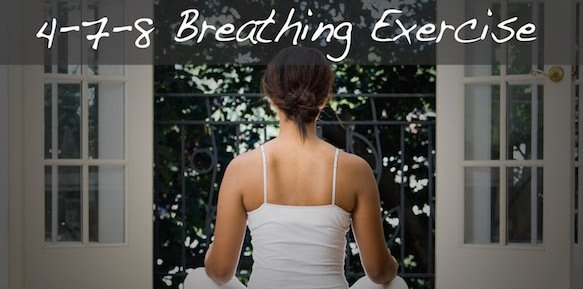19 Second Breathing Technique Induces Sleep ‘Almost Instantly’

The many pressures of life have contributed to a veritable epidemic of insomnia. People young and old, rich and poor everywhere have problems getting to sleep at night. Because the relentless stresses of post-modern life constitute the primary cause, insomnia does not seem to discriminate against any particular demographic … except one.
Those folks who really know how to relax and have adopted various stress management techniques seem to fare the best with getting a good night’s sleep. Of all the relaxation techniques one can utilize, none is as effective and fast-working as breathing techniques. There are actually several types of breathing techniques designed for different purposes, each executed according to various patterns and formulas.
Ayurveda, the science of life from India and mother of all healing arts, has much to offer the West, particularly where it concerns proper breath and breathing exercises. The various pranayamas of hatha yoga all find their source in this ancient system which extols the virtues of breath in the healing process.
With that background, an American physician has now developed a yoga-inspired breathing technique because of the many requests that he received from his insomniac patients worldwide. I’ts called the 4-7-8 Breathing Exercise.
“The 4-7-8 breathing technique was pioneered by Dr. Andrew Weill from Arizona, who describes the yoga-inspired method as ‘utterly simple, takes almost no time, requires no equipment and can be done anywhere.’
Dr.Weill claims that 4-7-8 breathing can help people fall asleep in just 60 seconds by acting as a ‘natural tranquilizer for the nervous system’ that reduces stress and tension in the body.” [1]
Related: 10 Amazing Health Benefits of Yoga

Given the massive demand and regular usage of sleep-inducing drugs, it’s no wonder that many are now willing to try an approach that is non-toxic and has no side effects. Not only that, the 4-7-8 Breathing Exercise costs nothing and is quite easy to perform. The following instructions can be followed by anyone just before bedtime or during the day just prior to meditation or taking a catnap.
“How do you do it?
1. Before you begin, place the tip of your tongue on the roof of your mouth just above your teeth and keep it there throughout the exercise.
2. Exhale completely through your mouth quite forcefully so you make a “whoosh” sound.
3. Close your mouth and inhale quietly and softly through your nose for a mental count of four.
4. Hold your breath and count to seven.
5. Next, exhale completely through your mouth, making another whoosh sound for eight seconds in one large breath.
6. Now inhale again and repeat the cycle three times for a total of four breaths.
Remember: All inhaling breaths must be quiet and through your nose and all exhaling breaths must be loud and through your mouth.” [1]
Many have asked how such a simple breath exercise can bring about the state of somnolence so quickly. There are very good scientific reasons for its effectiveness, as well as some practical ones.
“How does it help?
- It encourages the body to take in more oxygen and relaxes the parasympathetic nervous system thereby promoting a state of calmness.
- It helps rebalance the nervous system which can become over-stimulated during times of stress.
- It helps you connect with your body and your breathing, and distracts you from everyday thoughts that can prevent you from sleeping.” [1]
Conclusion
The buildup of daily tension, especially from the workplace, is perhaps the #1 cause of sleep disorders in America. The accumulation of stress over years can eventually translate into periodic bouts with insomnia. There is no better way to dissolve this tension than to adopt a regular practice of mediation and/or pranayama. Breathing techniques like the 4-7-8 Breathing Exercise are perfect for those with a busy schedule because it is easy to do and takes very little time.
The real key to deep relaxation is the breath. Watching the breath at any point during the day can be instrumental in diffusing the inevitable tension. By breathing in deeply, the oxygen is carried deep into the tissues; by breathing out long, the carbon dioxide is released from the body.
O2 by its very nature is relaxing; CO2 actually produces anxiety when it begins to buildup in the bloodstream. Ideally, the inbreathe and outbreath should be equal in length. The more balanced they are, the less agitated the mind will be. The more still that the mind is, the more relaxed the body will be … the easier it will be to get to sleep.

Sources:
[1] YAHOO Health

For those premature ejeaculators out there… Follow the same instructions for breathing that the article mentions. Except use a 10-10-10. Start before penetration. Enjoy!
I’ve read this before, I tried it and not really sure if I could call my results successful. What does work for me is a few minutes of first deep breathing and then progressive relaxation, knocks me out good =)
I have a variation on this method and it does work most of the nights; breathe in for 7; hold for 5 breathe our for 7. You should breathe deeply in so that you feel it in your kidneys. It has also made me start dreaming again. Perhaps a sign that I’m more relaxed and hitting REM sleep. I haven’t dreamt in years.
The graphic has an error in the sixth bullet. You don’t exhale through your mouth with your tongue on the soft tissue of your upper teeth. You do that when you want to exhale or inhale through your NOSE.